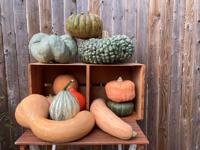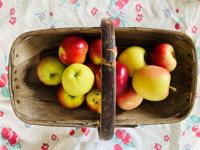When the summer season changes to autumn and the air temperature starts to chill, most of us start daydreaming about our favorite warm beverages and fall-time foods.
American culture seems to be overrun with foodstuffs flavored with “pumpkin spice.”
But it’s important to remember that there’s more to fall foods than pumpkin spice. Being adventurous with a larger variety of spices and herbs that complement the season can be a fun and easy way to reduce fat, sugar and sodium in dishes.
Herbs are the leaves or flowering parts found growing on some temperate, low-growing shrubs. Herbs can be used in both their fresh and dried forms, and examples of herbs include: parsley, chives, marjoram, thyme, basil, caraway, dill, oregano, rosemary, sage and celery leaves.
Spices originate from tropical plants and trees, and range in color from red to black. Spices come from a variety of plant parts: Cinnamon is a bark, ginger is a root, cloves are a bud, mustard is a seed, black pepper is a berry and paprika is a fruit.
Some plants bear both an herb and a spice, with an example being the plant Coriandrum sativum, which bears the herb cilantro from its leaves, and the spice coriander from its seeds.
By learning to flavor foods using herbs and spices, we can potentially remove salt, sugar and fats from recipes, helping to reduce the calories and sodium content of dishes we prepare.
Herbs and spices also contain substances called phytonutrients, which are natural elements that plants produce to protect themselves, and they also provide the plant with color, aroma and flavor.
Phytonutrients have also been shown to possibly promote potential health benefits, including heightened immunity, reduced inflammation, the sensation of fullness, enhanced insulin activity and reduced incidence of cancer.
Popular autumnal spices and herbs seeing attention in research studies on phytonutrients and health include cinnamon, clove, ginger, turmeric, rosemary and thyme. Cinnamon, for example, contains procyanidins and proanthocyanins. Research shows that these flavonoids can benefit our urinary tract and heart health.
Popular autumn herbs include basil, bay leaf, parsley, rosemary, sage, tarragon and thyme.
Popular autumn spices include cinnamon, ginger, allspice, cardamom, cloves, nutmeg, star anise, turmeric, cayenne pepper and pumpkin pie spice — a combination of cinnamon, ginger, nutmeg and clove.
Fall spices and herbs are excellent in flavoring warm beverages, sweet breads and desserts, and they also add character to meats, stuffing, rice dishes, vegetables and even fruits.
Try adding cloves to coffee or ginger to tea or on cooked carrots. Instead of sugar, add cinnamon to sweet potatoes or oatmeal, or sprinkle nutmeg on cooked spinach.
When adding herbs and spices to recipes, remember that dried herbs are more concentrated in flavor then fresh herbs.
The general equation for equivalence is that 1/4 to 1/2 teaspoon of dried, ground herbs or 1 teaspoon crumbled herbs equal 1 tablespoon of freshly cut herbs.
With both herbs and spices, it’s always recommended to start by adding small amounts, and then add more to taste. Likewise, when doubling recipes, do not double the herbs and spices; add 1 1/2 times the amount, taste, and then add more if needed.
Try and be purposeful with enjoying the flavors of fall this season.
Stacy Reed is an educator with Penn State Extension in Lancaster, specializing in food safety and nutrition.
The Link LonkOctober 07, 2020 at 05:59PM
https://ift.tt/34BFywE
Cooking with fall herbs, spices adds guilt-free flavor [Extension column] - Fly Magazine
https://ift.tt/3eCf9lu
Herb













No comments:
Post a Comment